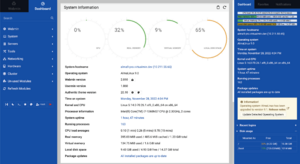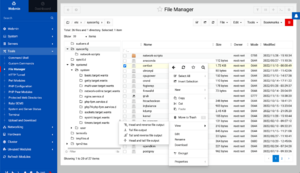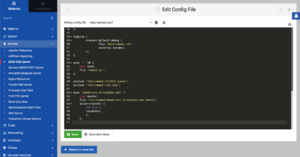Webmin facts for kids
 |
|
| Developer(s) | Jamie Cameron Ilia Rostovtsev and the Webmin community |
|---|---|
| Initial release | October 5, 1997 (version 0.1) |
| Stable release | Lua error in Module:Wd at line 1575: attempt to index field 'wikibase' (a nil value). (Lua error in Module:Wd at line 1571: attempt to index field 'wikibase' (a nil value).; Error: first parameter cannot be parsed as a date or time.) |
| Written in | Perl |
| Operating system | Linux (RHEL, Fedora, CentOS, AlmaLinux, Rocky Linux, Oracle Linux, Debian, Ubuntu), FreeBSD, OpenSUSE and other Unix-like operating systems |
| Available in | English, and other 41 languages |
| Type | Control panel |
| License | BSD 3-clause "New" or "Revised" License |
Webmin is a special tool that helps people manage computer servers. Think of it like a dashboard for a car, but for a computer system! It works on computers that use Unix-like operating systems, such as Linux.
With Webmin, you can easily change important settings on a computer. This includes managing user accounts, setting up how much disk space people can use, and controlling different programs. It also helps with popular open-source software like Apache HTTP Server (which runs websites) and MySQL (a database program).
Contents
The Story of Webmin
Webmin was created by a person named Jamie Cameron. The very first version came out in October 1997. Jamie made Webmin because he needed an easy way for people to change network settings without giving them full control of the computer.
Over time, Webmin got many new features. It now has different looks (called themes) and a dashboard. This dashboard shows how much of the computer's power, memory, and storage is being used. It also has a search bar to help you find things quickly.
Many people and companies have helped Webmin grow. They have added new parts (called modules), translated it into many languages, and given ideas to make it better.
In 2019, a security issue was found in some older versions of Webmin. This problem could have allowed someone to run harmful commands on the computer. The developers quickly fixed this issue. They believed the problem came from a bad change made to the code online.
Webmin has changed a lot over the years, with new looks and features. For example, Webmin 2.0 made internet connections more secure. It also gave users options when upgrading from older versions.
How Webmin Works
Webmin is mostly built using a programming language called Perl. It runs as its own program and has its own small web server. By default, it uses a specific internet port (number 10000) to communicate. It can also use SSL to make connections more secure, especially if you have OpenSSL installed.
Webmin is made up of over 110 standard parts, called modules. Each module helps manage a different part of the computer or a different program. This design makes it easy to add new features. Anyone interested can even write their own modules!
Webmin also lets you control many computers from one place. You can even log in to other Webmin computers on the same network easily.
Webmin is free to use and share under a special permission called the BSD license.
If you can't find a specific tool in Webmin, you can open a terminal window. This lets you type commands directly to the computer, which is useful if you can't use other ways to connect.
Why Webmin Isn't Always Included in Linux
Webmin used to be included in some Linux distributions, like Debian and Ubuntu. However, it was later removed from their official lists. This happened because Webmin sometimes changed computer settings in a way that didn't work well with how those Linux versions managed their own files. This could cause unexpected problems.
Other Programs Like Webmin
Webmin can be made even more powerful by adding extra modules. There are also two other big projects that work with Webmin:
- Usermin: This is like a simpler version of Webmin for regular users. It lets people do things like check their webmail or manage their own files, instead of managing the whole computer system.
- Virtualmin: This is a special tool for hosting websites. Virtualmin helps people create and manage websites for different internet addresses (domains). It gives both the computer administrator and the website owner an easy way to handle their websites.
In 2013, Webmin also released a special module for managing Minecraft servers. This module gives a basic way to control a Minecraft server. It's free and open-source, meaning anyone can use it without limits on how many players can join.
See also
- Virtualmin
- Usermin
- YaST





